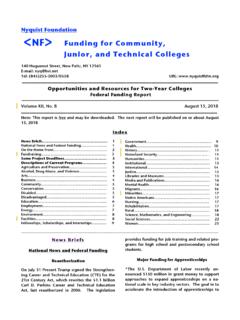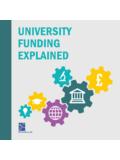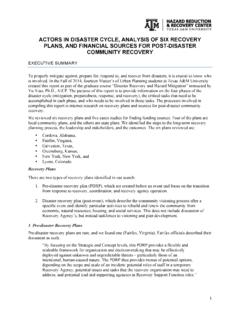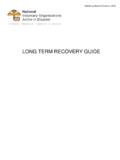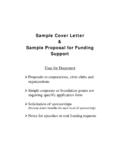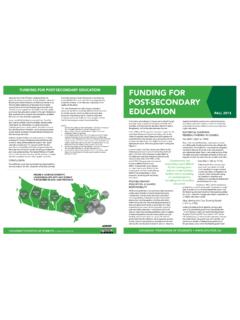Transcription of ISSUE BRIEF: PUBLIC SECTOR RESEARCH FUNDING
1 OECD Innovation Policy Platform ISSUE brief : PUBLIC SECTOR RESEARCH FUNDING The ISSUE in a nutshell This brief focuses on the nature and dynamics of existing FUNDING regimes for PUBLIC SECTOR RESEARCH (PSR) and the impact these regimes have on the contributions of publicly-performed RESEARCH to innovation. In regards to PUBLIC FUNDING , we distinguish between: block grant based regimes, where the majority of RESEARCH funds are allocated directly to institutions according to particular formulae, performance indicators or budget negotiations among actors; and project-based regimes where scientists obtain project funds from external sources competitively. Although the largest proportion of FUNDING for PSR comes from governmental sources (either federal/national or state/regional), the private SECTOR is also a source of FUNDING for PUBLIC RESEARCH through contract RESEARCH and service provision.
2 This ISSUE is extremely relevant for STI policy because FUNDING is one of the major instruments used to steer the science and innovation system. Many countries have introduced reforms in their RESEARCH FUNDING systems in order foster excellence, knowledge transfer and socio-economic innovation, reducing the proportion of institutional FUNDING without strings attached . The current trend towards more selective and competitive FUNDING was established some years ago. In addition, countries that increased their government budgets have often fed the investment towards specific programmes such as centres of excellence or towards the advancement of priority-specific RESEARCH sectors. Some countries also implemented performance-based RESEARCH evaluation systems with significant consequences for RESEARCH FUNDING at the institutional level.
3 The prioritisation of RESEARCH excellence has also been reflected in recent counter-cyclical trends in PSR FUNDING in some countries. Indeed, although in the past general levels of PUBLIC R&D FUNDING have normally mirrored the financial cycle, however, recently divergent paths between countries have been observed during the period of fiscal consolidation (OECD 2009a). There is debate about whether the increasing reliance on competitive project or program FUNDING at the expense of block grant and long-term institutional FUNDING has pressured PUBLIC SECTOR RESEARCH resulting in an emphasis on short-term, low-risk projects and away from longer term fundamental RESEARCH . There are also concerns about whether this negatively affects an institutions capacity to invest in infrastructure. It is difficult to balance performance-based FUNDING approaches with giving autonomy and flexibility to PUBLIC RESEARCH institutions.
4 Programme-oriented FUNDING also raises some concern in non priority areas. In either case, the diversification of the FUNDING portfolio of PUBLIC SECTOR RESEARCH organisations in relation to interactions with more social and economic actors may positively affect innovation performance. However, the conditions that generate markets and RESEARCH users are not the same for all scientific and technological areas. Likewise, institutional arrangements in different PSR organisations may either hinder or favour specific FUNDING strategies. The degree of external RESEARCH FUNDING diversity ( number of different agencies and foundations) has also affected institutional arrangements by increasing the pluralism of FUNDING sources. OECD Innovation Policy Platform PUBLIC SECTOR RESEARCH FUNDING OECD 2011 2 Who are the main actors? The main actors related to this ISSUE include both the recipients of FUNDING , such as Higher Education Institutions (HEIs) and PROs, and the funders themselves such as governments (federal/national and state/regional), international organisations, intermediary organisations ( RESEARCH councils), agencies (national and international), business, private foundations and donors.
5 In some countries, PROs may also fund their own institutes and researchers through intramural RESEARCH . In addition, legislators, advisory bodies and organised interest groups also play relevant roles such as contributing to agenda setting and influencing budget allocations. Finally, in systems where performance-based FUNDING exists, evaluation agencies and commissions are also relevant actors. A recent trend in most countries has been the diversification of actors involved and the greater complexity of the relations among them as well as increased FUNDING competition. Governments are traditionally the major funders of PUBLIC SECTOR RESEARCH . Governments fund RESEARCH either directly or indirectly. Direct FUNDING occurs through particular departments with competencies in the STI domain and they often have their own mission-oriented PUBLIC RESEARCH organisations and large national RESEARCH centres within their charts.
6 Conversely, indirect FUNDING occurs through intermediary RESEARCH FUNDING organisations such as RESEARCH councils or RESEARCH agencies. Governments show increased interest in improving their scientific output internationally but are providing less FUNDING without strings attached , thereby strongly emphasising scientific excellence and performance. RESEARCH FUNDING organisations are publicly-funded bodies responsible for co-ordinating and FUNDING the overall system and also particular areas of RESEARCH . Their budget may come from specific governmental departments or directly from legislative bodies. They are important meeting places for RESEARCH actors and the political administration in order to balance both political and scientific logics (Braun 1998). They occupy a key position in the RESEARCH system, especially in project-based FUNDING regimes.
7 The RESEARCH councils main task, traditionally, is to organise part of the FUNDING relationship between governments and RESEARCH organisations (and/or individual researchers and groups) as a peer review- based competition for project FUNDING (Rip 1994). In most countries, we have witnessed a transformation of these intermediary bodies. Their role is now more complex and includes additional tasks related to PUBLIC policy priorities and the promotion of structural changes via programme FUNDING . The extent to which the governance of the RESEARCH councils is intertwined with (and even dominated by) the scientific community varies across countries. The relative capacity of the councils to act strategically and to be real intermediaries between the state and science depends partly on that variance (van der Meulen 1998). OECD Innovation Policy Platform PUBLIC SECTOR RESEARCH FUNDING OECD 2011 3 In the past, the profiles of the different PSR organisations were more differentiated and their missions more specialised.
8 The diversification of roles for many of the different PUBLIC RESEARCH actors (universities, PUBLIC RESEARCH centres, etc.) led to common missions for RESEARCH , knowledge transfer and innovation which in the past were distinctive of some PSR actors more than others. Accordingly, in response to the common need for external FUNDING sources, the diverse organisations located in the PSR behave as collaborators (in order to gain critical mass) and as competitors. They also engage in interactions with the same political actors, apply to similar RESEARCH councils and agencies and compete for the support of the business SECTOR . What arrangements characterise PUBLIC SECTOR RESEARCH FUNDING ? Institutional block FUNDING provides RESEARCH organisations with a stable basis for RESEARCH activities. This can help them to acquire FUNDING from other sources, provides them with a certain degree of autonomy in the selection of their RESEARCH ; and allows them to build up expertise in new fields.
9 Conversely, a surplus of block FUNDING may de-incentivise organisations and researchers to look for FUNDING from other sources. When referring to institutional block FUNDING , it is useful to make a distinction between: pure block FUNDING , where recipients have a relatively large discretionary power on how to use these funds; and ear-marked funds , which can only be used to cover specific expenses such as the salary costs of permanent staff. Many countries have undergone a shift away from block FUNDING in favour of more project FUNDING . However, most European RESEARCH systems are still characterised by a higher share of block FUNDING when compared to the US system (Lepori et al. 2007). Several countries have introduced new performance based approaches to the distribution of institutional FUNDING (OECD 2010). For example, the United Kingdom, Australia and New Zealand have implemented national evaluation frameworks based on a different combination of quantitative and/or qualitative indicators (Coryn et al.)
10 2007, OECD 2010). FUNDING agencies use these evaluation outcomes as part of a FUNDING formula used to distribute part of the block FUNDING among HEIs. Therefore, this approach introduces an element of competition for block FUNDING based primarily on relative RESEARCH performance, doctoral training and/or the ability to acquire project and other external FUNDING . New block FUNDING can also be used to set up new centres or institutes. These have included organisations set up to do interdisciplinary RESEARCH or collaborative centres such as PRO-HEI and PUBLIC -Private hybrids. In the latter case, block and project FUNDING comes from both PUBLIC as well as private sources. OECD Innovation Policy Platform PUBLIC SECTOR RESEARCH FUNDING OECD 2011 4 However, project based FUNDING gives FUNDING organisations more control over RESEARCH . One rationale for increasing the relative share of competitive FUNDING is that it is expected to yield relatively higher returns in terms of knowledge creation and RESEARCH output.










